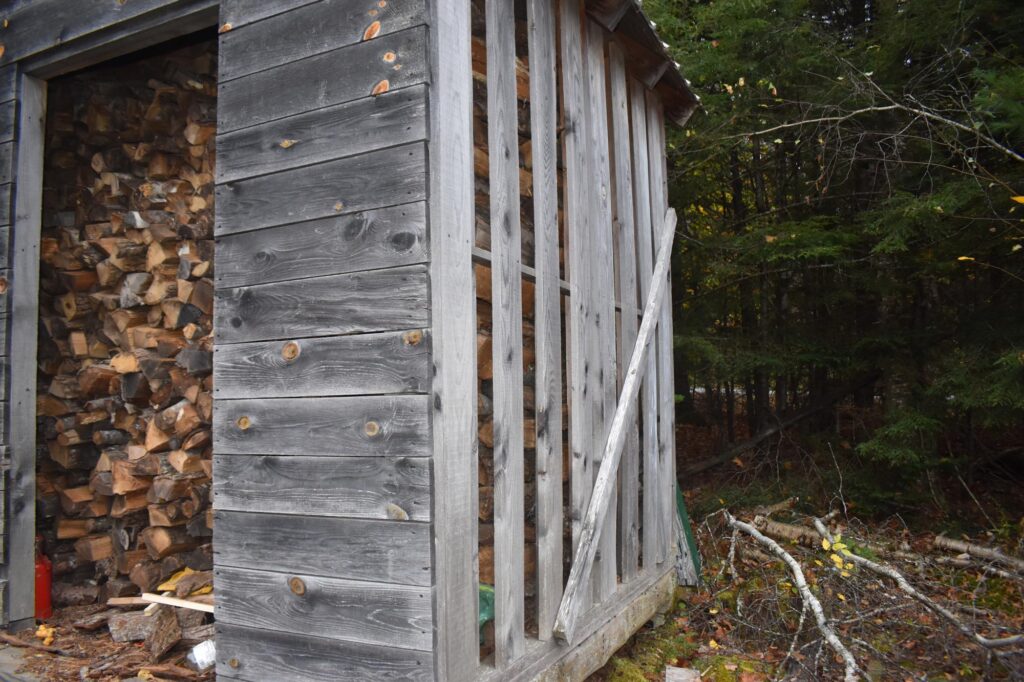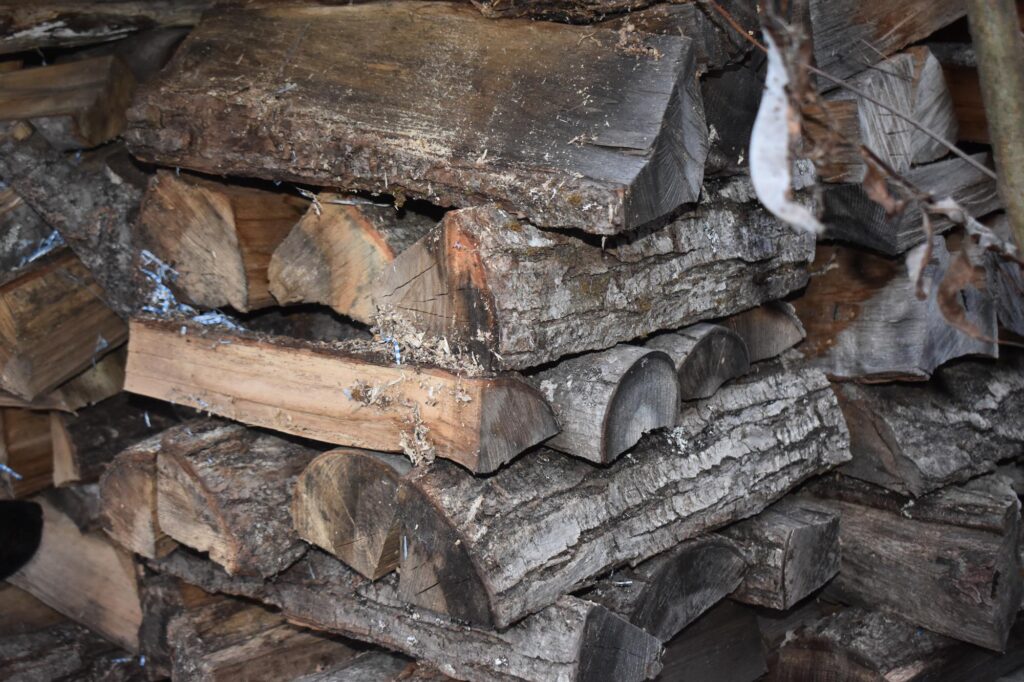Firewood is a great renewable resource to keep you warm in winter. The key to your survival in the cold, harsh outside world is having a fire that will keep you warm. If you don’t know how to season wood properly, then it won’t burn well. It will not produce as much heat and could clog your stove with dangerous creosote.
In addition, buying wet cut firewood (or cutting your own), can save money! (You can purchase wood already seasoned but it will cost significantly more!)
This article will show you some of the best ways to season your firewood so that it burns better and more safely!
What is seasoned firewood?
“Properly seasoned firewood” basically means that you take freshly cut firewood and, with a combination of sun and air circulation, wait while the wood dries.
Since unseasoned firewood burns poorly, you want to season firewood for as long as necessary to bring the moisture content of your wood pile down to where you will have a cleaner burn.
Why do you need to use seasoned wood?
Burning seasoned (dry) firewood fosters a more efficient burn, more heat, and less emissions and creosote build up in your chimney.
Wet wood produces a great amount of smoke as the fuel is burned off of the moisture on the fire. This moisture-laden smoke will dirty your chimney causing a stubborn and dangerous build up of creosote. The creosote build up in a chimney provides fuel for a potential fire. Although a fire in the stove is good, chimney fires can be dangerous!
It will also mean your stove glass will blacken significantly and the smoke released from burning wood could create harmful atmospheric pollution. By seasoning the wood it allows it enough time to allow moisture to evaporate before the fire starts.
The Environmental Protection Agency recommends that firewood burns better at moisture values of 15-20%. You can test firewood with a moisture meter. It will let you decide how long to season your firewood and help you ensure that you do not burn it too soon.
Factors in seasoning wood
Weather
The length of time it takes for gasoline to dry out is determined by the weather and local climate. Hot, dry summers speed up the drying process more than cool, wet seasons.
Time of the year wood is cut
Starting moisture content of wood will play a determining factors in the length of the wood that will dry. The higher starts to moisture level the longer wood has fallen away from recommended water content for fires.
In early spring, trees suck up tremendous amounts of water to support leaf production. So trees felled in the spring will be pretty wet! In the fall and winter, much more of the sap has drained.
Type of wood
Hardwood (deciduous trees) like oak and maple are much denser. Denser hardwoods may take longer to dry out than less dense softwoods like pine, spruce and hemlock.
How do I tell if firewood is seasoned?
Dry wood was heavier than green wood. When you hit two pieces of wet wood together they make a dull thud…dry wood resonates more…sounds like toy blocks being hit together. Dry wood banged together make more of a hollow sound.
The bark of dry wood is easy to remove, but the bark on green wood is difficult to remove.
Using a moisture meter
Moisture meters work by sending a small electrical charge through a piece of wood and measuring the resistance. The meter converts the resistance to a moisture percentage.
The EPA recommends a moisture level of 16-20% for optimal burn and fewer emissions.
To get the most accurate reading, split or cut the test piece in half just before using the moisture meter. That way, you get an accurate reading of the whole piece rather than just the outside.
Push the test prongs into the wood, push the button and note the digital readout.
How long should firewood be seasoned?
Seasoning firewood takes longer than you think! And wood burning stoves don’t really like unseasoned wood so give yourself plenty of time for seasoning firewood!
Most wood will take anywhere from 6 months to two years before the wood is seasoned.
It takes at least six months for softwoods to reach optimal dryness. Hardwoods like oak require between 1 and 2 years to dry properly.
How do I season firewood for a better burn?
Many times you can freshly cut wood in tree length logs to begin the initial drying. However, splitting and stacking it greatly accelerates the process.
If you immediately stack it in a woodshed, you don’t have to move it again, but it will dry more slowly.
If you stack it outside the shed, it will dry faster, but you will have to move it into the shed…or wallow through snowbanks to get it!
(Ideally, a woodshed can be more of a “pavilion” style structure…just a roof. Thus, air moves freely through it drying out the wood but the roof keeps precipitation off!)
I like to stack wood on pallets. You can often get them for free and keeping the wood off the ground not only keeps the wood from absorbing ground moisture but also provides better airflow.
A great way to find free pallets is to look on Craig’s list or your local want ads. Not only will they serve as a great storage rack for you wood to properly dry, but after a few years the pallet eventually falls apart and you can use it as kindling!
In addition to keeping split wood off the ground, you should also cover the stacks to keep them protected by rain and snow. While you can use tarps, I really like using pieces of metal roofing. They last a lot longer than tarps! However, be sure to weigh them down so that the wind doesn’t turn them into kites.
How do I store firewood?
I prefer not to keep a season’s worth of dry firewood inside the garage or basement. One, it doesn’t continue to dry as well and two, you could be potentially introducing ants, termites, and other insects to your home.
The best place for your firewood is outside a few feet from your house. Avoid placing on a wood wall too close because it could trap unwanted moisture against your house and in the unseasoned wood. (And you’re trying to reduce the moisture content!)
Really, a wood log storage shed or open-sided shed is ideal for the storage of wood outside.

Keep it outdoors
The best places for your logs to be properly seasoned are outdoors in daylight. Firewood that is stored in indoor spaces will not season properly and there are always risks of termites entering your property. If the rain is forecast there will be open-air storage that is another possible choice but check that all wood is getting airflow at the right level.
Stacking your firewood
When it comes time to stack the wood, there are two schools of thought. The first is that you should stack the pieces neatly on top of one another. This allows for airflow (which dries out your green wood), protects them from rain or snow, and allows it to properly season.
Some people have firewood stacked in long rows. In order to keep the ends from falling over, they criss-cross pieces at the end to create an “end stop.”

If the firewood is undergoing the seasoning process inside a building, you can just stack the ends against the walls. Be sure that the wall
However, some people feel that this takes too long and can be hard work with heavy pieces of wood. Instead, they recommend piling up the logs like a pyramid with alternating layers of green and seasoned wood – also called “lofting.” (This method works well if you’re storing your firewood outside.) In either case, be sure to completely cover your stack with tarps or metal roofing to protect it from precipitation!
Holz Hausen’s Method of Stacking Firewood
The Holz Hausen method of stacking firewood is a unique system that will create the perfect outdoor storage space. This method, which was invented by German forester Dr. Wolfgang Holzhausen, can be used for green or seasoned logs and uses four pillars to create an end stop.
The pillars are created by alternating green and dry wood with each layer stacked on top of one another in opposite directions so that they meet at the center point where they are fastened together to form a triangle shape.
When the wood dries out it becomes lighter than when it was wetter, so this allows you to move them around as needed until it has dried sufficiently without having to restack.
Conclusion
So, if you are going to burn wood, now you know how to season firewood, stack and store it!
Burning unseasoned firewood (when the moisture inside is higher than 20%) produces more smoke, more creosote, and burns inefficiently.
Seasoned wood burns cleaner, produces less smoke, and keeps your home warm!
Remember, it takes time to get firewood dry, so be sure to use the sun from the summer months as one of your best allies!
If you’ve found this article helpful, feel free to share and check out our other posts!
[…] Heaters require DRY wood. This may or not be a “con” since any firewood should really be seasoned. However, […]
[…] a couple of reasons. First, the whole point of splitting is to help it become "seasoned wood" (dry) as quickly as possible. So getting the inside of the logs open to the air accelerates a […]
[…] efficiently as possible, the moisture level should be between 15-20%. Check out my post on how to season wood properly and also my review on moisture […]